News & Articles
Browse all content by date.
To the Minnesota Department of Natural Resources (DNR), regarding PolyMet’s most recent permitting request:
(Email address: NorthMetPermitting.DNR@state.mn.us):
Here are my reasons that the DNR should reject PolyMet's permit applications for their earthen tailings dam, their liquid slurry pipeline pumping operation and their open pit sulfide mine near the headwaters of the St Louis River:
For starters, it is critically important to understand that the foreign Penny Stock company called PolyMet has a current share price of $0.63 per share, down from $1.50 per share in 2014. PolyMet, a total amateur in the business, has never operated a single mine in its short corporate life nor has it earned a single penny from mining. Their only income comes from selling shares to speculators and borrowing money from investors to pay their executives and employees. In addition, PolyMet, being an inanimate money-making corporation (that by definition has no conscience), cannot be trusted to tell the public about all the risks to the environment (including wildlife, fish, water, soil and air) that their exploitation of the earth could generate.
Therefore PolyMet can be expected to hide the fact that their operations could easily cause a massive environmental catastrophe similar to what happened at Mount Polley, British Columbia in 2014 (carefully study the article further below for the frightening details). Mount Polley was a state of the art copper mining operation.
Every citizen stakeholder that is potentially adversely affected by PolyMet’s operation deserves to be fully informed by (theoretically) unbiased regulators such as the MN DNR about the potentially catastrophic risk to the water users who happen to live downstream from the massive tailings lagoon, whose (eventual) 250 foot high earthen dam is at a high risk of failing in some way or other sometime in the future, especially in the event of a large deluge of rain, an earthquake or a design flaw that could cause the earthen dam to dissolve, leak, over-top or structurally fail in some other way, including being damaged by sabotage. The risks will exist for eternity, since the toxic metals (see list below) in the lagoon will never degrade into non-toxic forms.
In addition, the vulnerable pipeline that will carry the toxic sludge from the processing plant to the slurry pond is at high risk of sabotage, with serious environmental contamination that could possibly be even worse than the bursting of a dirty frack oil pipeline such as could happen from the foreign pipeline company Enbridge as it transports dirty oil from the tar sands in Canada or from the Bakken oil fields in North Dakota. I don’t believe that PolyMet has dealt with the possibility of sabotage.
Up to this point, both PolyMet and Twin Metals (and all of the governmental agencies that have been involved in the approval process) have been seriously neglectful in educating the public about all the potential lethal dangers of either the pipeline or the massive amount of toxic liquids that will forever cause the deaths of any water bird that lands on the lake-like lagoon (a la Butte, Montana’s ever-lastingly poisonous mining tailings “pond” and the nearby defunct Berkeley open pit mine [now a toxic “lake”] that has had its water pumps shut down and is now nearly filled to the brim with poisonous water that has high levels of dissolved toxic metals and a pH approximating that of stomach acid!).
It seems to me that the MN DNR would be exceedingly naïve if it trusts PolyMet’s promises to treat the water from the tailings pond by some pie-in-the-sky reverse osmosis or other de-watering plan that has not yet been tried on a commercial level. Those promises are theoretical and should not be trusted.
To more fully understand the importance of the Butte, Montana disaster, I attach below an aerial view photo of Butte’s serious SuperFund site that will be impossible for the EPA to remediate. Every attempt to de-acidify or alkalinize the tailings lagoon has failed miserably. And now, the future of the city of Butte, which was once happily promised jobs, jobs, jobs by the copper bosses, is extremely bleak. Butte, whose rivers and streams experience regular fish kills due to the copper mine-caused water contamination, is becoming de-populated. Could the same thing happen to downstream communities in northern Minnesota?
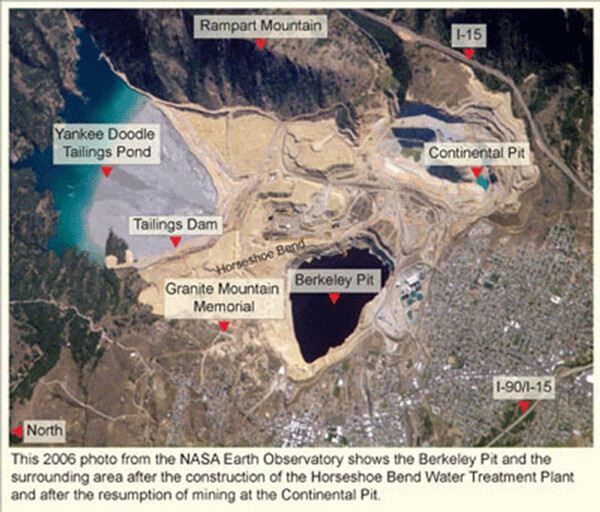
(See my article about the Butte environmental catastrophe that was published at http://www.scoop.co.nz/stories/HL1612/S00062/poisoned-snow-geese-in-butte-toxic-nature-of-copper-mining.htm.)
The DNR, the EPA, and the Forest Service are surely ethically - and also legally, I hope - obligated to adequately educate and fully inform every citizen that relies on the drinking water that is in the nearby aquifers about all of the dangers of extracting (and grinding up into a fine powder) low-grade copper sulfide or nickel sulfide ore (99+% of which is hazardous waste material), whether the risks are catastrophic or minor.
One cannot expect the full disclosure of all risks by any corporation, whether it is a major trans-national mining corporation like Glencore or Antofagasta or a rookie Penny Stock company like PolyMet or Twin Metals. Their share-holders and corporate executives would not stand for totally full disclosure, because such information could adversely affect their investments or the company’s prestige.
Regulatory agencies like the DNR are ethically obligated to inform those of us whose precious and increasingly threatened water is at high risk of being contaminated, especially if the culprits are foreign corporations that have investors who don’t live here. The St Louis River – and thus Lake Superior – is definitely at risk of contamination if the dam fails or the pipeline breaks or is sabotaged. Any such failure – whether gradual or sudden - will impact millions of people, animals and plants downstream.
In the worst case scenario (the Mount Polley scenario), the St Louis River watershed (and therefore Lake Superior) will be poisoned to such a degree that it will never be remediable or usable for fishing, hunting, farming, wild rice harvesting, canoeing, swimming and drinking by those who will never benefit from a copper mine. Even a trillion dollar escrow account posted by PolyMet would be woefully inadequate to meet the costs of an environmental catastrophe like Mount Polley.
The chances of the failure of an earthen tailings dam with walls that are 250 feet high and resulting in an environmental disaster in northern Minnesota will significantly increase every time the dam needs to be raised. The raising of an earthen dam by large bulldozers adding potentially dissolvable additional earth (of what consistency?) is of itself a risky effort, since each level will necessarily have to be narrower and narrower and therefore increasingly more likely to leak, liquify and/or burst.
Why we Should Fear the Creatures from the Black PolyMet Lagoon
The public needs to understand that the liquid slurry that is piped into the lagoon by a pipeline system of uncertain length or safety will surely contain toxic levels of some of the following common sulfide-mining toxic by-products (that are only safe if the remain buried in the ground as sulfide ore: Lead, Arsenic, Nickel, Zinc, Cadmium, Vanadium, Antimony, Manganese and Mercury. This list of hazardous waste minerals were the ones that were present in large quantities in the contaminated sludge that destroyed Mount Polley’s Hazeltine Creek and Quesnel Lake and contaminated the Fraser River.
Duluth residents, representing the largest concentrated population that could be adversely affected by a copper/nickel mine disaster upstream, need to be fully informed that, in the event of a leak or full-fledged collapse of the dam, the fishable, swimmable St Louis River and eventually Duluth’s drinking water from Lake Superior will be contaminated, perhaps mortally and irretrievably.
Earthen dams are notorious for dissolving and collapsing, especially in the presence of certain weather circumstances that are out of the control of any mine operator. One only has to consider the frequent flash floods that result from a sudden deluge of rain similar to the one Duluth experienced a few years ago - and which are increasingly common all over our warming, climate-unstable planet.
To back up this testimony, I offer the following videos - plus an eye-opening article about the Mount Polley environmental disaster of 2014, which should make the DNR decision-makers reject PolyMet’s permits. Mount Polley is considered the worst environmental catastrophe in the history of Canada. And it was man-made (actually corporate-made). Thank you for your attention. Gary G. Kohls, MD, Duluth, MN _______________________________________________________________________ PS: I ask the MN DNR committee that is evaluating the PolyMet’s permit applications to please watch the following videos:
1)https://www.youtube.com/watch?v=33lhPsd7L1c
2) https://www.youtube.com/watch?v=jmJY5D4fNM8
3) https://www.youtube.com/watch?v=SfanpPz8HeA
4) https://www.youtube.com/watch?v=xAItFxc8bME&feature=youtu.be 5) https://www.youtube.com/watch?v=vg3yd8GPSnA
Then study the following article:
Duty to Warn
The PolyMet and Twin Metals Copper Mining Projects and the Lethal Risks to the St Louis River Watershed, Lake Superior and the BWCA Acceptable Risks for Foreign Investors, but What About the Potential Victims Downstream?
Gary G. Kohls, MD - 1-31-17
https://www.transcend.org/tms/2017/02/the-polymet-project-and-the-lethal-risks-to-the-st-louis-river-watershed-and-lake-superior/
“ALL tailings "ponds" are problems. If they don't breach and spill massive amounts of toxic sludge into the environment like at Mount Polley, they leach that contamination slowly, poisoning the waters and lands around them.” -- From: http://canadians.org/blog/update-mount-polley-mine-disaster-imperial-metals-and-government-focus-covering-instead;
In 2016, the Duluth News-Tribune published a Local News article with the title “EPA signals its support for final PolyMet review”. The article ended with what I regard as an intentionally deceptive and woefully insufficient sentence: “Critics say the project is likely to taint downstream waters with acidic runoff.”
In a column for the Duluth Reader, which I wrote in response, I attempted to correct the notion that “acidic runoff” is the major reason for the widespread opposition to PolyMet’s proposed copper/nickel mining project (and the Twin Metals Project, which is adjacent to the pristine In a column for the Duluth Reader, which I wrote in response, I attempted to correct the notion that simple “acidic runoff” is the major reason for the widespread opposition to PolyMet’s proposed copper/nickel mining project (in addition to the Twin Metals Project, which is adjacent to the pristine Boundary Waters Canoe Area Wilderness). Both PolyMet and Twin Metals, it should be mentioned, are Penny Stock companies from Canada and are total novices when it comes to operating copper/nickel sulfuric acid-producing mines. The companies have never earned a penny producing a product. All their operating budgets have come from loans, speculators, major transnational mining corporations and other investors that are hoping that the regulatory agencies will succumb to corporate and public pressure,so that the mines will be built and they can cash in on their investments.
Typical of many media outlets that depend on advertising revenues from Big Business, the Duluth News-Tribune failed to report on a recent catastrophic “tainting of downstream waters” that had happened a couple of years earlier in Canada.
The Mount Polley Copper Mining Disaster of 2014
On August 4th, 2014 the earthen dam holding back the massive mine tailings lagoon at the Imperial Metals Mount Polley (British Columbia) gold and copper mine burst. The dam breach suddenly unleashed around 25 million cubic meters of toxic sludge containing heavy metals, processing chemicals and other hazardous waste material that could have filled 9,800 Olympic-sized swimming pools. The toxic sludge flowed into Polley Lake, then into the tiny Hazeltine Creek and then into the previously pristine Quesnel Lake and the Quesnel River, a tributary of the 800 mile-long Fraser River, a migratory Sockeye salmon-bearing river that empties into the Georgia Strait and the Pacific Ocean at Vancouver, B.C.
Typical of most government and industry responses to such catastrophic mining industry failures, Stephen Harper’s Conservative Party government of Canada – not to mention the ruling Liberal Party government of British Columbia - tried to cover up the disaster. Therefore most North Americans on either side of the border (certainly us Minnesotans) were unaware of the event, thanks in part to our co-opted corporate-controlled media that failed to adequately report on the disaster.
Immediately below are links to dramatic photos and videos that have been available to the US government and media agencies, but which were not reported on the evening news of either local or regional media outlets.
Imperial Metals Corporation of Vancouver, the owner of the mine, acknowledged that they, as do all sulfide mining operations, had been regularly piping massive amounts of toxic metals into the slurry (aka “slime”) pond in the years leading up to the failure of the earthen dam. See the photos below.
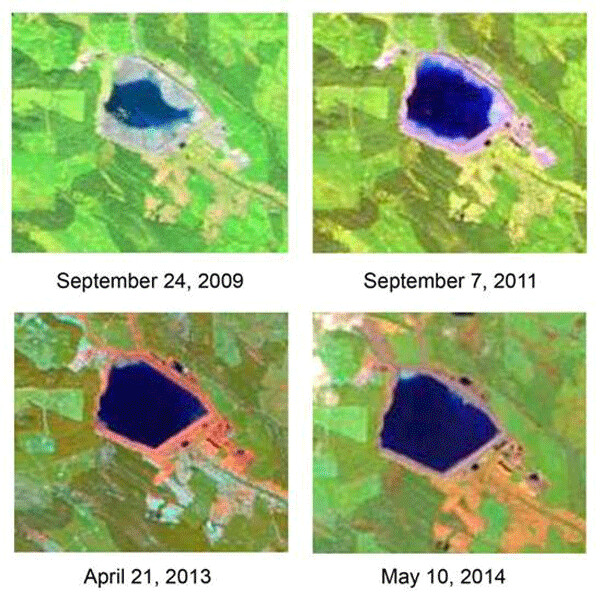
A series of high-altitude photos of the progressively filling tailings lagoon from 2009 to just before it breached August 4, 2014
The following list of hazardous waste minerals that had been dumped into the “tailings” pond is taken from Environment Canada’s website at: (http://www.ec.gc.ca/inrp-npri/donnees-data/index.cfm?do=disposal_details&lang=En&opt_npri_id=0000005102&opt_report_year=2013.
Environment Canada reported that the poisonous metallic contaminants that had been dumped in the tailings pond included: Lead, Arsenic, Nickel, Zinc, Cadmium, Vanadium, Antimony, Manganese and Mercury.
Each of these 9 heavy metal contaminants are highly toxic to all life forms and have no safe levels in drinking water or in the serum or tissues of humans or other animals. These contaminants, commonly found in hard rock sulfide mines, are also lethal to plant life, but only when the rock has been ground up into fine powder that is necessary in the copper extraction process. It is important to understand that polluted aquifers can never be de-toxified by any known process.
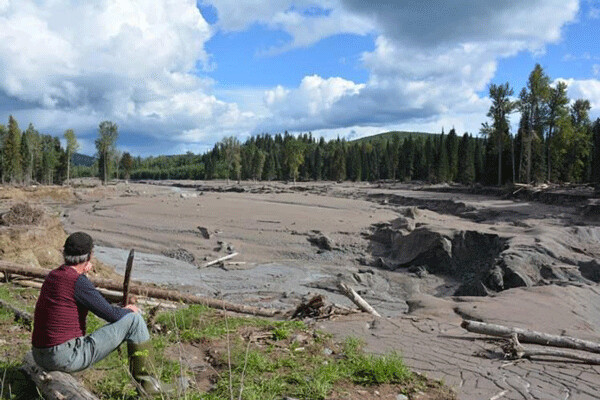
The photo above was taken soon after the Mt Polley tailings pond failure. It pictures what was once the tiny, 6 foot wide Hazeltine Creek near its mouth at Quesnel Lake . Photo courtesy of Clayoquot Action, Tofino, BC (www.clayoquotaction.org)
Below is a selection of links to some of the many videos of the Mount Polley tailings pond dam failure:
https://www.youtube.com/watch?v=33lhPsd7L1c
https://www.youtube.com/watch?v=GfMolg5Ul_0
https://www.youtube.com/watch?v=SfanpPz8HeA
https://www.youtube.com/watch?v=xAItFxc8bME&feature=youtu.be
https://www.youtube.com/watch?v=vg3yd8GPSnA
And here is an important video of an experimental tailings dam breach that can happen to any earthen dam:
https://www.youtube.com/watch?v=bWEWVw7TGk4
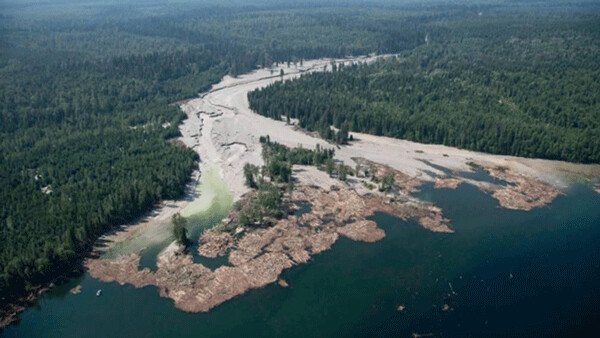
The birds-eye view of the mouth of the tiny (normally about 6 feet wide) Hazeltine Creek (now 120-150 feet wide) as it enters into Quesnel Lake, the previously deepest, purest lake in British Columbia and a famous trout and salmon fishery; that is, until August 4, 2014, when 24,000,000 cubic meters of toxic water and sludge breached the Mt Polley mine’s tailings dam and exploded downstream. The tan material in the photo represents millions of floating dead trees that were swept away in the massive sludge flood.
Immediately below are satellite photos of Imperial Metals’ Mt Polley copper/gold mining facility before and after it suddenly dissolved and broke in 2014. Note the change in color of the tailings pond, the nearby lakes and the widening of the Hazeltine Creek that directed the toxic sludge into Quesnel Lake. The creek had been invisible to satellite photos until the flood.
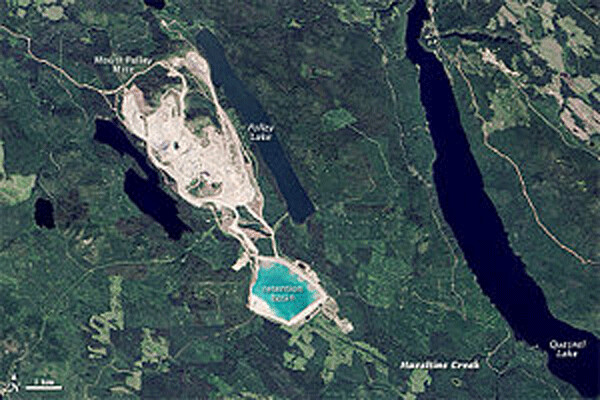

All these photos depict what are considered the biggest environmental disasters in the histories of Canada and could, someday in the near or distant future, represent what could happen to Minnesota’s St. Louis River watershed, since highly toxic metal tailings/sludge/slurry/slime ponds have a substantial risk of failing, especially in the case of one of our planet’s increasingly common (seemingly annual) 100-year catastrophic floods, storms or downpours. These photos are posted at: https://en.wikipedia.org/wiki/Mount_Polley_mine_disaster#Imperial_Metals_history
A Final Thought
Northern Minnesotans, Native American Water Protectors (like the heroes at Standing Rock), sportsmen, environmentalists, downstream businesses, wild rice harvesters, fish, game, birds and just plain working folks whose babies and other vulnerable beings with developing brains need non-toxic water to thrive or simply survive must understand that such relatively common catastrophes could destroy the aquifers in the BWCAW, Birch Lake, the Partridge River, the Embarrass River, the St. Louis River, the city of Duluth and ultimately, Lake Superior.
In the considered opinion of many ethical thinkers, any human with an ounce of morality would conclude that the risks of allowing amateur mining companies such as PolyMet and Twin Metals – and other similarly amoral, non-human corporations like Switzerland’s GlencoreXstrata or Chile’s Antofagasta are too great. (Glencore and Antofagasta are the two major multinational mining corporations that control PolyMet and Twin Metals.) The plans to open and operate sulfuric acid-producing copper mines in pristine watersheds that are just upstream and upwind from children and other living things should be shelved for the good of the planet. But somehow, the legislators who are often in bed with their corporate paymasters are quite willing to ignore the risks in favor of a few temporary jobs. The risks seem to be OK for conscienceless corporations and their investors, but they don’t live here.
States that surround the potentially poisoned wilderness areas as well as Lake Superior and the other downstream great lakes should have a say in the issue. Bullying corporations, along with their co-opted friends in positions of power in state and national capitals are quite willing to risk permanent catastrophes such as Mt Polley.
They, being the sociopathic entities that they are, can’t be expected to act as ethical humans, especially when billions of dollars are involved.
_ Dr Kohls is a retired physician from Duluth, MN, USA. He writes a weekly column for the Duluth Reader, the area’s alternative newsweekly magazine. His columns deal with the dangers of American fascism, corporatism, militarism, racism, malnutrition, Big Pharma’s psychiatric drugging and over-vaccination regimens, and other movements that threaten the environment, prosperity, democracy, civility and the health and longevity of the populace. Many of his columns are archived at http://duluthreader.com/search?search_term=Duty+to+Warn&p=2; https://cse.google.com/cse?cx=017930374292714292268%3Avw5cotp1r2c&q=gary+kohls+articles&sa=Search&siteurl=consortiumnews.com%2Farchives%2F&ref=consortiumnews.com%2Fabout%2F&ss=3193j1359707j10#gsc.tab=0&gsc.q=gary%20kohls%20articles&gsc.page=1 or at https://www.transcend.org/tms/search/?q=gary+kohls+articles
| Tweet |


